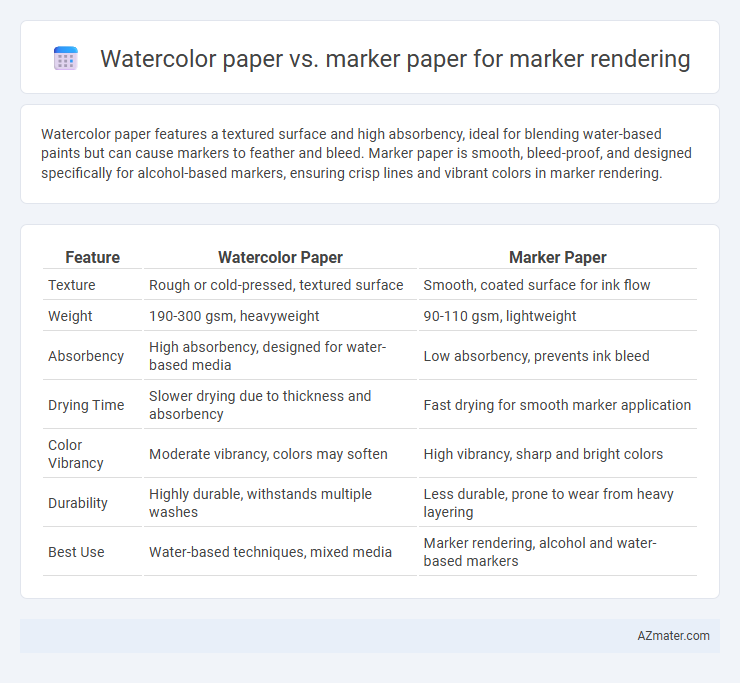Watercolor paper features a textured surface and high absorbency, ideal for blending water-based paints but can cause markers to feather and bleed. Marker paper is smooth, bleed-proof, and designed specifically for alcohol-based markers, ensuring crisp lines and vibrant colors in marker rendering.
Table of Comparison
| Feature | Watercolor Paper | Marker Paper |
|---|---|---|
| Texture | Rough or cold-pressed, textured surface | Smooth, coated surface for ink flow |
| Weight | 190-300 gsm, heavyweight | 90-110 gsm, lightweight |
| Absorbency | High absorbency, designed for water-based media | Low absorbency, prevents ink bleed |
| Drying Time | Slower drying due to thickness and absorbency | Fast drying for smooth marker application |
| Color Vibrancy | Moderate vibrancy, colors may soften | High vibrancy, sharp and bright colors |
| Durability | Highly durable, withstands multiple washes | Less durable, prone to wear from heavy layering |
| Best Use | Water-based techniques, mixed media | Marker rendering, alcohol and water-based markers |
Introduction to Marker Rendering
Marker rendering demands smooth surfaces like marker paper that prevent bleeding and allow even ink application, essential for precise color layering and blending. Watercolor paper, although textured and absorbent, can disrupt marker flow and cause uneven ink absorption, hindering sharp line work and vibrant color effects. Artists prioritizing marker techniques benefit from marker paper's optimized surface, ensuring crisp details and consistent coloration in their renderings.
Key Characteristics of Watercolor Paper
Watercolor paper features a textured, absorbent surface designed to hold wet media without warping, making it ideal for blending and layering watercolor paints. Its heavyweight construction, typically ranging from 190 to 300 gsm, supports multiple washes while maintaining durability. The paper's cold-pressed or rough finish enhances pigment retention and allows for subtle gradations, which can influence marker rendering by affecting ink absorption and diffusion.
Key Characteristics of Marker Paper
Marker paper features a smooth, non-porous surface designed to prevent ink bleed and ensure crisp, vibrant lines, making it ideal for marker rendering. It is typically thin yet resistant to feathering, allowing precise color layering and blending without warping or bleeding through to the other side. Compared to watercolor paper, marker paper's surface texture is less absorbent, which helps maintain marker ink integrity and enhances color vibrancy in illustrations and designs.
Surface Texture: Smooth vs Textured
Marker paper offers a smooth surface texture specifically designed to prevent ink bleed and allow precise, clean lines for marker rendering. Watercolor paper features a textured surface that absorbs ink differently, creating unpredictable effects and often causing marker bleed or uneven color application. Choosing marker paper ensures sharp, consistent results, while watercolor paper provides more tonal variation but less control for marker-based artwork.
Paper Weight and Thickness Comparison
Watercolor paper typically ranges from 190 to 300 gsm, providing a thick, textured surface that absorbs marker ink well without warping, ideal for wet media blending. Marker paper is usually thinner, around 70 to 90 gsm, with a smooth, non-absorbent finish designed to prevent bleeding and promote crisp lines. The substantial thickness of watercolor paper offers durability for multiple layers, whereas the thinner marker paper excels in quick-drying and vibrant color layering for marker rendering.
Ink Absorption and Bleed Control
Watercolor paper features a textured surface designed to absorb and disperse liquid pigments, reducing ink bleed for marker rendering but can cause feathering with heavily pigmented inks. Marker paper is specifically engineered with a smooth, non-porous surface that limits absorption, preventing bleed-through and maintaining crisp lines while enabling vibrant color layering. Optimal ink absorption on watercolor paper lends to softer blends, whereas marker paper's bleed control ensures precision and enhanced color intensity in detailed marker artwork.
Color Vibrancy and Layering Potential
Watercolor paper offers a textured surface that enhances color vibrancy by allowing pigments to settle into the fibers, resulting in rich, luminous hues ideal for blending and layering multiple washes. Marker paper features a smooth, bleed-resistant finish that preserves crisp lines and prevents ink feathering, but it often limits layering potential due to its non-absorbent surface which can cause colors to sit on top and potentially smudge. For marker rendering emphasizing vivid colors and extensive layering, marker paper ensures sharpness and color integrity, while watercolor paper supports deeper tonal variation through its absorbent texture.
Blending Techniques on Each Paper Type
Watercolor paper features a textured surface ideal for blending marker ink through layering and feathering, allowing pigments to meld gradually for smooth gradients. Marker paper has a smooth, non-absorbent finish that prevents ink from soaking in, enabling seamless marker blending by layering transparent colors without feathering or bleeding. Understanding the distinct absorbency and texture of each paper type enhances blending techniques, optimizing marker rendering results.
Longevity and Preservation of Artwork
Watercolor paper offers superior longevity and preservation due to its thicker, acid-free composition that resists warping and fading over time, making it ideal for intricate marker rendering that demands archival quality. Marker paper, while optimized for smooth ink absorption and vibrant color display, tends to be thinner and less durable, which can lead to quicker degradation and color bleeding on long-term exposure. Choosing watercolor paper enhances the durability and archival preservation of marker artwork, ensuring colors remain vivid and paper integrity is maintained for decades.
Choosing the Best Paper for Your Marker Rendering Style
Watercolor paper offers a textured surface ideal for blending water-based markers, enhancing gradients and washes with superior absorbency and durability. Marker paper features a smooth, bleed-resistant finish designed specifically for markers, allowing precise line work, vibrant colors, and quick drying. Selecting the best paper depends on your rendering style: choose watercolor paper for fluid, painterly effects and marker paper for sharp, detailed illustrations with minimal feathering.

Infographic: Watercolor paper vs Marker paper for Marker rendering
 azmater.com
azmater.com